2022届高考英语二轮复习:名词和代词课件(69张)
文档属性
| 名称 | 2022届高考英语二轮复习:名词和代词课件(69张) |  | |
| 格式 | pptx | ||
| 文件大小 | 304.4KB | ||
| 资源类型 | 教案 | ||
| 版本资源 | 通用版 | ||
| 科目 | 英语 | ||
| 更新时间 | 2022-03-02 16:31:56 | ||
图片预览

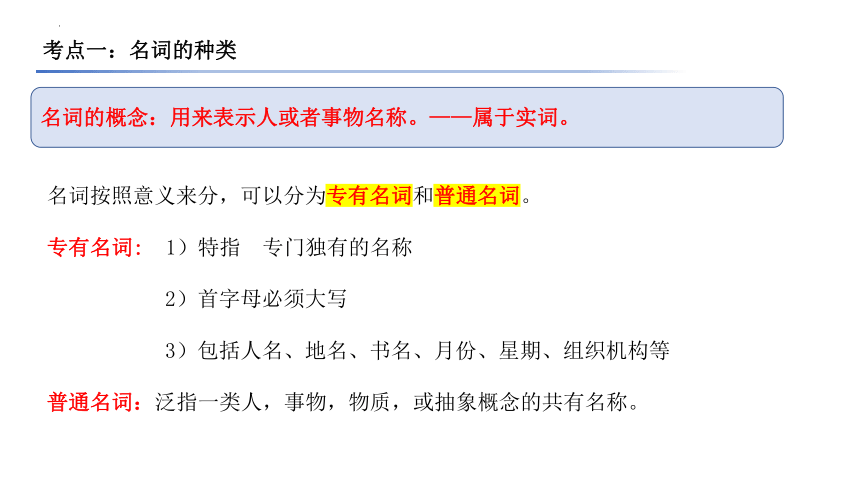
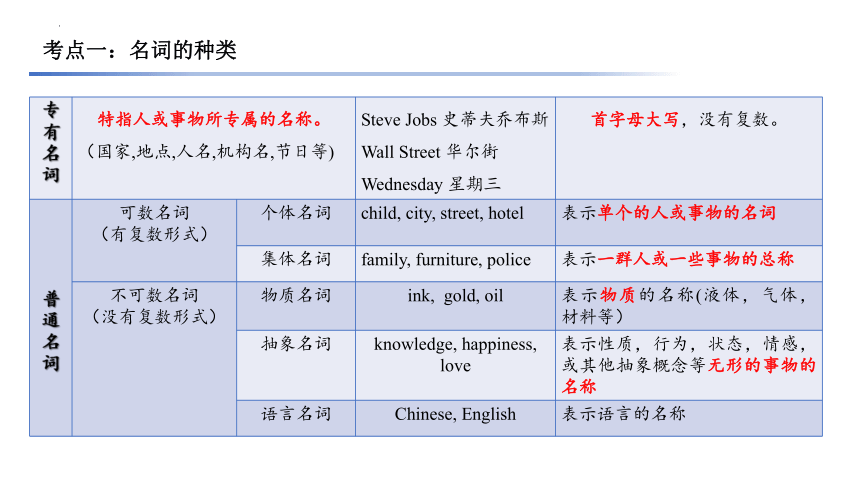
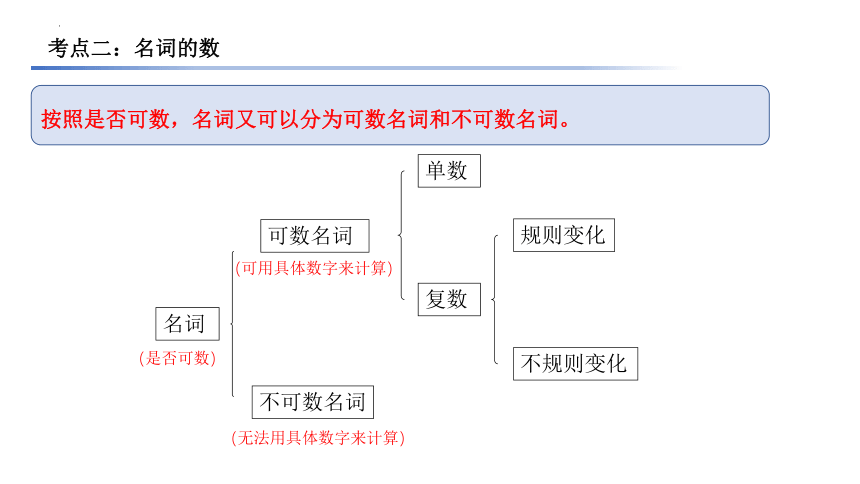
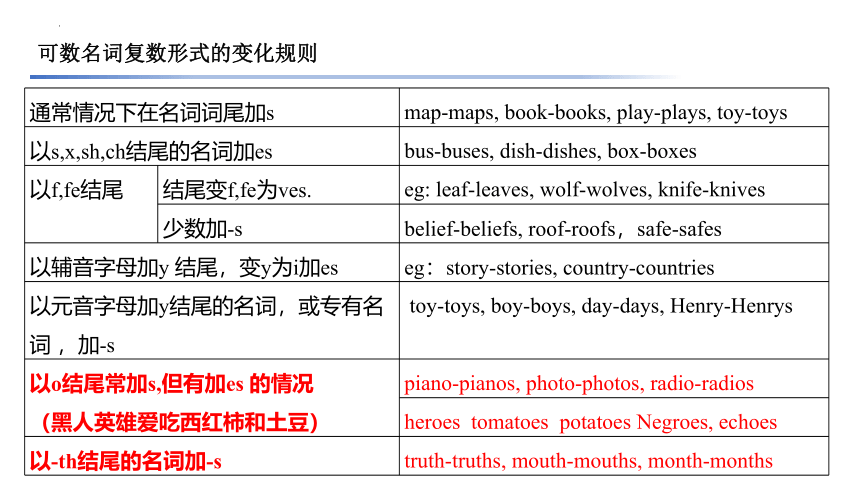
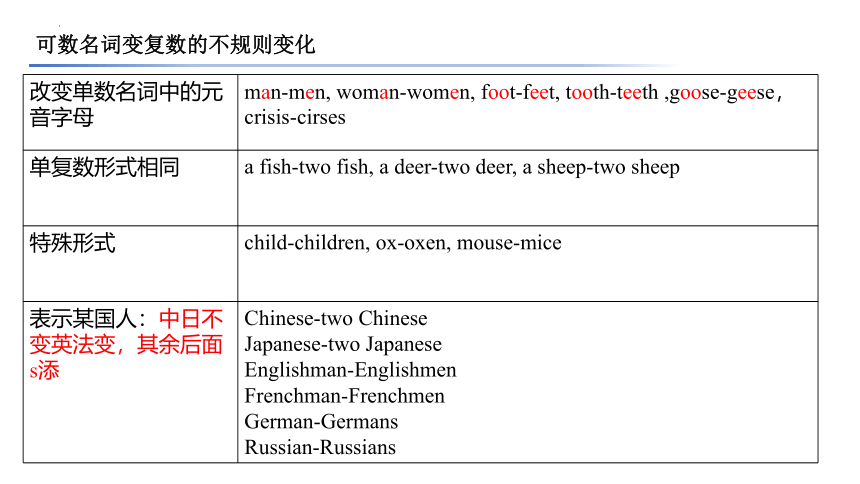
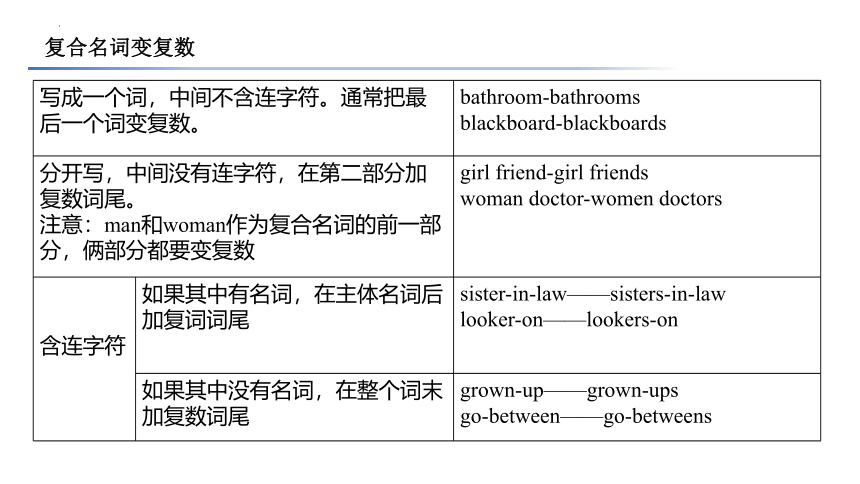



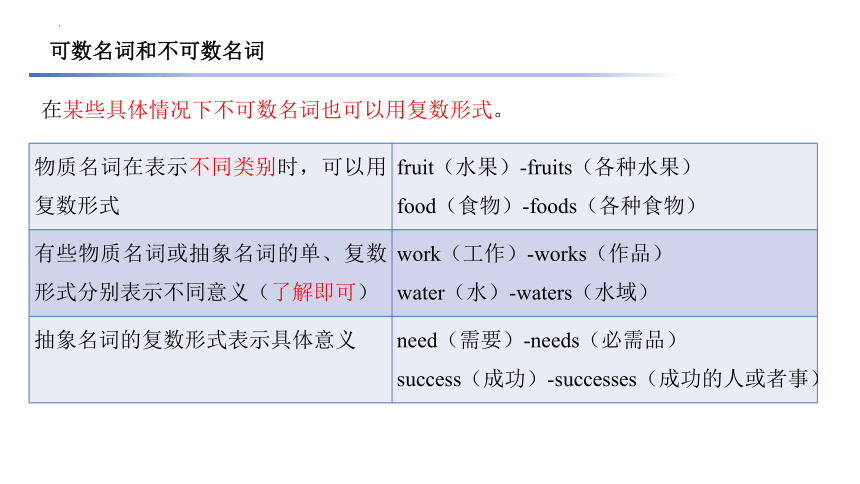

文档简介
(共69张PPT)
名词的考点
考点一:名词的种类
名词按照意义来分,可以分为专有名词和普通名词。
专有名词: 1)特指 专门独有的名称
2)首字母必须大写
3)包括人名、地名、书名、月份、星期、组织机构等
普通名词:泛指一类人,事物,物质,或抽象概念的共有名称。
名词的概念:用来表示人或者事物名称。——属于实词。
专有名 词 特指人或事物所专属的名称。 (国家,地点,人名,机构名,节日等) Steve Jobs 史蒂夫乔布斯 Wall Street 华尔街 Wednesday 星期三 首字母大写,没有复数。
普通名词 可数名词 (有复数形式) 个体名词 child, city, street, hotel 表示单个的人或事物的名词
集体名词 family, furniture, police 表示一群人或一些事物的总称
不可数名词 (没有复数形式) 物质名词 ink, gold, oil 表示物质的名称(液体,气体,材料等)
抽象名词 knowledge, happiness, love 表示性质,行为,状态,情感,或其他抽象概念等无形的事物的名称
语言名词 Chinese, English 表示语言的名称
考点一:名词的种类
考点二:名词的数
按照是否可数,名词又可以分为可数名词和不可数名词。
可数名词
不可数名词
复数
单数
规则变化
不规则变化
名词
(可用具体数字来计算)
(无法用具体数字来计算)
(是否可数)
可数名词复数形式的变化规则
通常情况下在名词词尾加s map-maps, book-books, play-plays, toy-toys
以s,x,sh,ch结尾的名词加es bus-buses, dish-dishes, box-boxes
以f,fe结尾 结尾变f,fe为ves. eg: leaf-leaves, wolf-wolves, knife-knives
少数加-s belief-beliefs, roof-roofs,safe-safes
以辅音字母加y 结尾,变y为i加es eg:story-stories, country-countries
以元音字母加y结尾的名词,或专有名词 ,加-s toy-toys, boy-boys, day-days, Henry-Henrys
以o结尾常加s,但有加es 的情况 (黑人英雄爱吃西红柿和土豆) piano-pianos, photo-photos, radio-radios
heroes tomatoes potatoes Negroes, echoes
以-th结尾的名词加-s truth-truths, mouth-mouths, month-months
可数名词变复数的不规则变化
改变单数名词中的元音字母 man-men, woman-women, foot-feet, tooth-teeth ,goose-geese,crisis-cirses
单复数形式相同 a fish-two fish, a deer-two deer, a sheep-two sheep
特殊形式 child-children, ox-oxen, mouse-mice
表示某国人:中日不变英法变,其余后面s添 Chinese-two Chinese
Japanese-two Japanese
Englishman-Englishmen
Frenchman-Frenchmen
German-Germans
Russian-Russians
复合名词变复数
写成一个词,中间不含连字符。通常把最后一个词变复数。 bathroom-bathrooms
blackboard-blackboards
分开写,中间没有连字符,在第二部分加复数词尾。 注意:man和woman作为复合名词的前一部分,俩部分都要变复数 girl friend-girl friends
woman doctor-women doctors
含连字符 如果其中有名词,在主体名词后加复词词尾 sister-in-law——sisters-in-law
looker-on——lookers-on
如果其中没有名词,在整个词末加复数词尾 grown-up——grown-ups
go-between——go-betweens
考点链接
This game is designed to make children prepare for the future work they will do as ______.
A. grown-up
B. grown-ups
C. growns-up
D. growns-ups
Twenty percent of the teachers in our school are______.
A. woman teachers
B. womens’ teachers
C. women teachers
D. woman’s teachers
不可数名词不能用具体数字来计算,因此前面不能用不定冠词a、an,一般也没有复数形式。
常考的不可数名词:
advice, baggage, furniture, homework, luck, information, knowledge, luggage, news, progress, traffic, equipment.
damage——破坏,损失,不可数名词。
damage——损害赔偿金。可数名词。
hair——一个人的全部头发,不可数名词。
hair——一根根的头发,可数名词。
不可数名词
物质名词在表示不同类别时,可以用复数形式 fruit(水果)-fruits(各种水果)
food(食物)-foods(各种食物)
有些物质名词或抽象名词的单、复数形式分别表示不同意义(了解即可) work(工作)-works(作品)
water(水)-waters(水域)
抽象名词的复数形式表示具体意义 need(需要)-needs(必需品)
success(成功)-successes(成功的人或者事)
在某些具体情况下不可数名词也可以用复数形式。
可数名词和不可数名词
考点三:名词的量
英语中常用可数名词和单位词搭配来表示名词的量。不可数名词不能以个数计算,对不可数名词的计量也要用单位词。
1.表示一些
some+
可数名词复数形式(some students)
不可数名词 (some water)
2.表示许多
a lot of , lots of, plenty of(lots of birds / lots of milk)
many+可数名词的复数形式
much+不可数名词
考点三:名词的量
3、表示少
修饰可数名词的复数形式
(几个【表肯定】) a few
(几乎没有【表否定】)few
修饰不可数名词
(一点【表肯定】 )a little
(几乎没有【表否定】 ) little
具体的数量
1.可数名词的数量表示:基数词+可数名词的单数/复数
an/one orange 一个橘子 twelve schools 十二所学校
2.不可数名词的数量表示:借助于可表示单位的词来表示,这些“单位”有单复数。具体结构:
1)a/an+单位名词的单数+of+不可数名词 a piece of news 一则新闻
2)基数词(>1)+单位名词复数+of+不可数名词 two pieces of news两则新闻
注意:可数名词也可以借助于表示单位的词来表示。
例如: a basket of apples 一篮子苹果
考点三:名词的量
修饰可数名词复数的短语:
a great/good many; a number of; numbers of; a majority of; dozens of(几十,很多); hundreds of(成百上千的); thousands of(成千上万的)
修饰不可数名词的短语:
not a little(很多); an amount of=amounts of(许多);
a bit of(一点)
既可以修饰可数名词的复数形式也可以修饰不可数名词的短语:
lots of =a lot of =plenty of; a variety of(各种各样的)= varieties of; a quantity of(一些); the majority of(大多数)=most of; the rest of; enough of;
考点三:名词的量
考点四:名词的格
名词的格有主格,宾格,所有格三种形式。
主格做主语,宾格做宾语。名词的主宾格没有形式变化。
名词的所有格表示所有或者所属关系。根据词形变化有‘s, of, 和双重所有格。
‘s 所有格的构成
通常情况下,在名词后直接加’s
The teacher’s house,passers-by’s words
以s或者es结尾的复数名词,在名词后加’
The doctors’ office the masses’ advice
以s结尾的专有名词的所有格一般只加’,有时也可加’s
James’ house=James’s house
Burns’ poems=Burns’s house
考点四:名词的格
‘s 属格的用法
①用于人或动物等有生命的名词词尾。
Her family’s pride Helen’s room
②表示店铺,某人家等名词的所有格后面,一般省略它所修饰的名词。
The doctor’s , the barber’ s
③也可用于国家,城市,时间,距离等无生命的名词后。
the country’s plan,a mile’s journey,Today’s newspaper
④表示各自的所有关系时,各名词末尾均须加’s
Jane’s and Mary’s bikes
⑤表示共有的所有关系时在最后一个词末加’s
Jane and Mary’s bike
考点链接
It is____________ from this school to the hotel you stay at.
A. drive of an hour B. an hour’s drive
C. an hour drive D. an hour of drive’s
考点链接
____________ bicycles are both red.
George and Annie’s
George ‘s and Annie’s
George and Annie
George’s and Annie
of 所属格
2.表示无生命的东西的所有格形式,通常用“名词+of+所有者”,如:
the title of the novel
the workshops of the plant
注:某些有生命的东西也用of所有格
(1)当名词较长时the works of Mark Twain, the speech of President Xi
(2)当修饰名词的定语较长时Do you know the name of the teacher standing over there
(3)当“the+adj.” 表示一类人或物修饰名词时
The living standard of the disabled should be improved.
特别提示:1、表示全部和部分关系,来源,内容等时,用of所属格。
Some of the students, a story of adventures
2、of +抽象名词, 相当于形容词。
前面可以用great, vital, much, no, some, low等词修饰。
of great value=very valuable
The work I am doing is not of much value. 我做的工作没有多大价值。
of 所属格
双重所有格:有不定冠词、数词、不定代词、指示代词(a, two, some, this, that)等修饰的名词,常用“of+所有格”,表示许多中的一个(或一部分),如:
a book of my brother’s
some inventions of Edison’s
that beautiful daughter of your sister’s
of 所属格
名词在句中主要作主语、宾语、表语、定语和补语等成分。
1、作主语: Hard work is more important than high intelligence in achieving success.
2、作宾语: Your real friends can give you suggestions openly.
3、作表语: When work is a pleasure, life is a joy.
4、作定语: Have you received the Christmas present
5、作补语: Education is hard work, but it can be made interesting work.
名词的句法功能
1.当名词作定语时,几乎总是用单数形式(即使在意义上是复数)。
shoe repairers修鞋的人 tooth brushes牙刷
2.sports, customs, arms, clothes, sales 作定语时,仍用复数形式。
a sports car一辆赛车 a customs officer一名海关官员
talks table谈判桌 the foreign languages department外语系
sales plans 销售计划 a goods train一列货运火车
名词作定语
3、数词+名词做定语
①如果有连字符,直接用单数。
A two –year contract
A ten-mile walk
②如果没有连字符,名词需要变成其对应的单复数形式。
A one year contract
A two years contract
A two years’ contract
名词作定语
代词的考点
人称代 词 主格 I, you, he, she, it, we, you, they
宾格 me, you, him, her, it, us, you, them
物主代 词 形容词性 my, your, his, her, its, our, their
mine, yours, his, hers, its, ours, theirs
名词性
反身代词 myself, yourself, himself, herself, itself, ourselves,yourselves, themselves
指示代词 this, that, these, those, such, some
疑问代词 who,whom,whose,whoever,which,whichever,what,whatever.
关系代词 that,which,whom,who,whose,as
不定代词 one/ some/ any, each/ every, none/ no, many/ much,
few/ little/ a few/ a little
other/ another, all/ both, neither/ either
复合不定代词 some, any, every, no都能和one, body, thing一起构成复合不定代词
考点一:人称代词的用法
(1)人称代词的主格可用作主语。
She broke her leg while skiing.
We live in China and she is a great country.
(表示国家,城市,大地,月亮等名词时,可用she来指代,表示一种亲密的感情)
(2)人称代词的宾格可用作宾语或者表语。
We often go to see her on Sundays.
Both his parents and teachers are proud of him.
It(主语)is(系动词)me(宾格做表语)
系动词
1.be 动词:am is are / was were
2.感官动词:
look(看起来) smell (闻起来) sound (听起来) feel(摸起来) taste(尝起来)
3.变化:get become turn(颜色的变化) grow
4.保持:keep remain stay stand
5.似乎,好像:seem=appear
(3)it的常考用法
①it 替代不定式作形式主语或形式宾语(P.85—86)。
To reconsider this matter is very important.
= It is very important to reconsider this matter.
I consider it advisable to tell her beforehand.
常见的以it作形式主语或形式宾语的动词:feel, consider, find, believe, make, take, imagine, prove, think, suppose, regard等。
句型:it is +adj +(for sb) +to do sth
It(形式主语)is important for us to learn English well(真主后置)
考点一:人称代词的用法
(3)it的常考用法
②it 替代动名词(短语)作形式主语
it代替动名词(短语),常用于“It is no good / no help / no use / fun / useless / worthwhile...... +动名词(短语)” 结构中。如:
It is no use wasting time discussing how it happened.
It is worthwhile making another try. 再试一次是值得的。
考点一:人称代词的用法
(3) it的用法。
③it 替代名词性从句作形式主语或者形式宾语。
该结构中的名词性从句可用that, what, when, whether等引导。如:
It is not known what caused the accident. 尚不清楚事故的起因。
考点一:人称代词的用法
④it 用于指时间、天气和距离等(需要辨别出来)。
It(主语)is raining(谓语)now(时间状语). 天正在下雨。
代替上文提到的一件事物 My book is missing. I can’t find it anywhere.
代替指示代词this, that ---What’ s this ---It’s a car.
指代时间、季节 It often rains in spring here.
指代气候、天气、温度、自然环境等 In Britain it is neither too cold in winter nor too hot in summer.
指代距离 It’s four kilometers from my home to the farm.
指代不明性别的婴儿 ---Who’s the baby in the photo ---It’s me.
指代远处的人或者敲门者等不能确定对方身份的人 Open the door, please. It may be the police.
作形式主语 It’s not easy to get him to change his mind.
作形式宾语 She found it difficult to get along with him.
用于强调结构 It was he who bought a shirt at this shop yesterday.
某些及物动词(like, love,enjoy, prefer, hate,appreciate等)之后若没有出现宾语,而直接跟if/ whether引导的状语从句要在从句前使用代词it。 I’d appreciate it if you could come in tonight.
(4)两个及以上的人称代词并列使用时,单数人称的顺序为2-3-1 (即你—他—我),复数人称的顺序为1-2-3 ( 即我们—你们—他们)。
The teacher wanted ( ) to do the work.
A. Jim, you and I
B. I, Jim and you
C. you, Jim and me
D.Jim, me and you
考点一:人称代词的用法
指示代词是用于指代上下文中所出现的人或事的代词,表“这个”、“那个”、“这些”、“那些”等概念,有单复数之分。
考点二:指示代词
单数形式 复数形式
this 这个 that 那个 these 这些 those 那些
such 如此的(事) such 如此的(事)
same 同样的(人、事) same 同样的(人、事)
考点二:指示代词
1、指示代词在句中可作主语、表语、宾语或定语。如:
We must make sure this(主语)doesn’t happen again.
我们必须确保此事不会再次发生。
I like these(宾语), while he likes those(宾语).
我喜欢这些,而他喜欢那些。
What I really want to say is this(表语).
我真正想说的就是这一点。
This(定语)picture is more beautiful than that(定语)one.
这张图片比那张更漂亮。
考点二:指示代词
2、this, these 一般指时间或空间上较近的人或物,而that, those则常指时间或空间上较远的人或物。
① This is a deer and that is a tiger.
这是一只鹿,那是一只老虎。
② These are television sets. Those are computers.
这些是电视机,那些是电脑。
考点二:指示代词
3、this和these常指后面要讲到的事物,有启下的作用,而that和those常指前面提到过的事物,有承上的作用 。
What I want to tell you is this the meeting is put off till Friday.
我要告诉你的是这个(事情):会议推迟到星期五举行。
He had a bad cold. That was why he didn't attend the meeting.
他得了重感冒,那就是他没参加会议的原因。
推迟:put off=delay=postpone
参加会议:attend the meeting
4、为避免与前面的名词重复,可以用that或those来代替,其中that指代可数名词单数或不可数名词,those指代可数名词复数。
His own experience was different from that of his friends.
他自己的经历和朋友们的经历不同。
Computers made in Nanjing are as good as those made in Shanghai.
南京生产的电脑和上海生产的一样好。
考点二:指示代词
In terms of(在......方面;就......而言)education systems, one cannot say that the system in one country is better than ______.
A. that of another
B. another
C. one of another
D. one another
考点链接
it/one /that三者均可用作代词, 指代前面提到的名词。
it指代同名同物
I have lost my umbrella; I'm looking for it.
one与that则指代同名异物
one为泛指, 相当于a/an+名词
that为特指, 相当于the +名词
A chair made of steel is stronger than one made of wood.
The water in the cup is hotter than that in the pot.
考点二:指示代词
辨析:it/one /that
one只能代替可数名词单数, 代替可数名词复数时用ones;
that既可以代替不可数名词也可以代替可数名词单数, 代替可数名词复数时用 those。
There were a few young people and some older ones in the house.
Mary's handwriting is far better than that of Peter.
These pictures are more beautiful than those.
考点二:指示代词
辨析:it/one /that
— Can I help you
— I’d like to buy a present for my father’s birthday, ______ at a proper price, but of great value.
A.which B.that C.one D.it
考点二:指示代词
物主代词是表示所有关系的代词,有“形容词性”和“名词性”之分。名词性物主代词多数是由形容词性物主代词后加s构成。但his和its的两种形式一样(后边只要一个s),而my则变为mine。
考点三:物主代词
单数 复数
第一人称 第二人称 第三人称 第一人称 第二人称 第三人称
形容词性物主代词 my your his,her,its our your their
名词性物主代词 mine yours his,hers,its ours yours theirs
名词性物主代词=形容词性物主代词十名词。
— Is that your pen 那是你的钢笔吗
— No, it is hers.(hers=her pen) 不是,是她的。
考点三:物主代词
考点三:物主代词
形容词性和名词性物主代词虽都译成“......的”,但形容词性物主代词只能作定语,不可单独使用,后边须有名词;
I’m sure you don’t want to listen to all my explanations.
His views are different from those of others.
名词性物主代词具有名词的性质,后边不可再加名词,它在句中可作主语、宾语或表语。
We compared scores and found that theirs were higher than ours.
You have taken the wrong gloves; they are hers.
Miss Wang is an old friend of mine.
考点四:反身代词
在句子中作宾语或表语,表示“......自己”。
That young man has been teaching himself French.
That poor boy living alone by himself was myself.
2.在句子中作名词或代词的同位语,用来加强语气,表示“亲自,本人”,一般置于被说明的词之后。
Why do I always have to do everything myself
You had better ask the patient himself about his condition.
考点五:疑问代词
疑问代词指用来表达疑问或构成疑问句的代词。主要的疑问代词及其功能如下:
(1) who在句中多用作主语、宾语或表语。
Who told you
Who locked the door of the classroom yesterday
Who did you tell the news
(2) whom是who的宾格,在句中用作介词或动词的宾语。
Whom did you go to the cinema with
你和谁一起去了电影院
考点五:疑问代词
(3)whose表示“谁的”,可用作定语、主语、表语和宾语。
Whose pronunciation is the best
谁的发音最好呢
Whose are these
这些是谁的?
(4)what和which都可以在句中作主语、宾语、表语和定语。
What happened to him last year
去年他身上发生了什么事情
Which do you prefer, the red one or the white one
你喜欢红色的那个还是白色的那个
Which is the right way for you 对你来说哪个是合适的方法呢
What job do you want to find 你想找什么样的工作
考点五:疑问代词
考点六:不定代词
辨析1:both, either, neither, none, all, any
都 任何 都不
俩者 both either neither
三者 all any none
Jackie and I are both self-employed.杰克和我都自己当老板。
Either your watches or mine is wrong.不是你们的表不准, 就是我的表不准。
Neither the boys nor the girls are to blame for this .男孩们和女孩们都不应该为此受到责备。
All the flowers are gone. 所有的花都谢了。
I don’t like any of the flowers. 这些花我都不喜欢。
I like none of the flowers. 这些花我都不喜欢。
不定代词:不指明代替任何特定对象的代词。
考点六:不定代词
both 作主语谓语动词用复数形式。后常跟of 短语,接复数名词of可以省略,接复数代词of不能省略。
Both (of )my children are at school now.
Both of us can speak English.
还可以构成both…and…结构。
Both he and his wife enjoy tennis.他和他的妻子都喜欢网球。
辨析1:both, either, neither, none, all, any
either 和 neither 都能接of 短语。
either...or... 要么,要么…
neither...nor... 既不,也不…
You can park on either side of the street.这条街的俩边都可以停车。
Neither of us agrees with the plan.我们双方都不同意这个计划。
辨析1:both, either, neither, none, all, any
考点六:不定代词
考点六:不定代词
None都不,毫不。none of sb/sth
I wish I could offer you some cake, but there ‘s none left.
None of us cares about what has happened to him.
辨析1:both, either, neither, none, all, any
考点链接
They submit(提交) two reports, but _______ of them contains any useful suggestions.
all
none
either
neither
考点六:不定代词
each和every都表示“各个,每个 ”。each有名词和形容词两种用法,可做主语、宾语、同位语,定语。当它作主语时,谓语动词用单数形式;every仅有形容词用法,作定语,修饰名词时谓语动词也要用单数形式。
each 可指两个或两个以上的人或事物,而every只可指三个或三个以上的人或事物。I asked all the children and each told me a different story.
The dean(系主任) had talk with each of us.
They searched every person and every room in the house.
Every one of us has strong and weak points.
辨析2: each与every
考点六:不定代词
补充用法:every表达每隔,每逢:
1、every+基数词+复数名词
2、every+序数词+单数名词
There are buses to the station every ten minutes=every tenth minute.
辨析2: each与every
考点六:不定代词
few 很少,几乎没有。 a few有几个,一些。
修饰或者代替可数名词复数。
Few members planed to vote for him .很少有成员计划投他的票。
I know a few of those people.这些人当中我认识几个。
little 很少,几乎没有。 a little 有一些。
He knows little about electronics.他对电子学几乎一窍不通。
I know a little about electronics. 我懂一点电子学。
辨析3:few, a few, little, a little
考点六:不定代词
辨析4:other, the other, others, the others, another
不定代词 意 义 用法说明
other 其他的 作为形容词来使用,即只作定语,后跟名词:
I want some other books.
others 泛指其他的人或物 作为名词性物主代词来使用,后面不接名词: In working with others, we should be patient.
the other 特指两者(范围)中另一个 one...the other..一个...另一个...:
He has three sons, two are in college and the other is in high school.
the others 特指两个范围中其余所有的人或物 some …the others一些,剩下的
Some students come from China, the others from Japan.
another 任何一个,另一个 用作形容词或代词,指三者或三者以上中的另一个或用于表示另外的。还可用于another +数词+可数名词结构。
We need another 3 days (= 3 more days) to finish the job.
考点链接
To stay awake, my brother finished two cups of coffee and ordered ______.
A. the other
B. another
C. the others
D. other
考点六:不定代词
somebody (某人) anybody (任何人) nobody (没有人) everybody
(每人)
someone (某人) anyone (任何人) no one (没有人) everyone
(每人)
something (某事) anything (任何事) nothing (没有东西) everything
(每一件事)
辨析5:复合不定代词
some和any均表示“一些”,用法有所区别:
some多用于肯定句,any多用于疑问句和否定句
Do you have any bookmarks No, I don’t have any bookmarks.
I have some questions to ask.
some用于疑问句中,表示盼望得到肯定的答复,或者表示建议,请求等:
Would you like some bananas
Could you give me some money
考点六:不定代词
some和any均表示“一些”,用法有所区别:
any多用于疑问句、否定句和条件句中,也可以用在肯定句中,表示“任何”。Would you like some tea 你想喝点茶吗 (邀请) Yes, please. 好的。
There is always some fruit on the table, but today I can’t find any.
桌上总是有一些苹果,但是今天我什么也没找到。
some和数词连用表示“大约”,any可与比较级连用表示程度:
例1.There are some 3,000 students in this school.
例2.Do you feel any better today
考点六:不定代词
some和any均表示“一些”,用法有所区别:
考点六:不定代词
One has to do one's best.每个人都要尽力而为。
One must know oneself.人要有自知之明。
Such a drug will make one find it hard to go without it.这种毒品会使人感到离了它不行。
one作主语时,其相应的物主代词可用one's或his,反身代词可用oneself或himself,
重复主语时可用one或he。
补充:① one用来代替人,泛指"人"、"任何一个人",在句中作主语或宾语。
考点六:不定代词
补充:辨析:no one, nobody, none
no one=nobody,两者均只能指人,不能指物;用作主语时,谓语动词一般用单数。
No one (Nobody) knows. 谁也不知道。
No one (Nobody) likes it. 没人喜欢它。
注:两者之后均不能接 of 短语。
none既可指人也可指物,其后通常接 of 短语;
若指不可数名词,谓语只能用单数,若指可数名词,则谓语可用单数。
None of the food was left. 一点食物都没留下。
None of the books is (are) interesting. 没有一本书有趣。
考点六:不定代词
补充:辨析:no one, nobody, none
考点六:不定代词
补充:辨析:no one, nobody, none
none 暗示一种数量,指数量上“一个也没有”。在回答 how many 或 how much 的提问时,通常用 none。
no one 或 nobody 往往表示一种全面否定,指“谁都没有”。在回答 who 的提问时,通常用 no one 或 nobody。
How many English books have you read ——None.
How much money did you give her ——None.
Who went to see the film ——No one (Nobody).
考点七:相互代词
相互代词是表示相互关系的代词,在句中常作宾语。译作“相互,彼此”。
主格和宾格 所有格
each other each other’s 彼此的
one another one another’s 彼此的
We’re not exactly on intimate terms, but we see each other fairly often.
我们虽算不上关系密切,但经常见面。
You should listen to one another’s opinions a bit more.
你们应该多倾听一点彼此的意见。
名词的考点
考点一:名词的种类
名词按照意义来分,可以分为专有名词和普通名词。
专有名词: 1)特指 专门独有的名称
2)首字母必须大写
3)包括人名、地名、书名、月份、星期、组织机构等
普通名词:泛指一类人,事物,物质,或抽象概念的共有名称。
名词的概念:用来表示人或者事物名称。——属于实词。
专有名 词 特指人或事物所专属的名称。 (国家,地点,人名,机构名,节日等) Steve Jobs 史蒂夫乔布斯 Wall Street 华尔街 Wednesday 星期三 首字母大写,没有复数。
普通名词 可数名词 (有复数形式) 个体名词 child, city, street, hotel 表示单个的人或事物的名词
集体名词 family, furniture, police 表示一群人或一些事物的总称
不可数名词 (没有复数形式) 物质名词 ink, gold, oil 表示物质的名称(液体,气体,材料等)
抽象名词 knowledge, happiness, love 表示性质,行为,状态,情感,或其他抽象概念等无形的事物的名称
语言名词 Chinese, English 表示语言的名称
考点一:名词的种类
考点二:名词的数
按照是否可数,名词又可以分为可数名词和不可数名词。
可数名词
不可数名词
复数
单数
规则变化
不规则变化
名词
(可用具体数字来计算)
(无法用具体数字来计算)
(是否可数)
可数名词复数形式的变化规则
通常情况下在名词词尾加s map-maps, book-books, play-plays, toy-toys
以s,x,sh,ch结尾的名词加es bus-buses, dish-dishes, box-boxes
以f,fe结尾 结尾变f,fe为ves. eg: leaf-leaves, wolf-wolves, knife-knives
少数加-s belief-beliefs, roof-roofs,safe-safes
以辅音字母加y 结尾,变y为i加es eg:story-stories, country-countries
以元音字母加y结尾的名词,或专有名词 ,加-s toy-toys, boy-boys, day-days, Henry-Henrys
以o结尾常加s,但有加es 的情况 (黑人英雄爱吃西红柿和土豆) piano-pianos, photo-photos, radio-radios
heroes tomatoes potatoes Negroes, echoes
以-th结尾的名词加-s truth-truths, mouth-mouths, month-months
可数名词变复数的不规则变化
改变单数名词中的元音字母 man-men, woman-women, foot-feet, tooth-teeth ,goose-geese,crisis-cirses
单复数形式相同 a fish-two fish, a deer-two deer, a sheep-two sheep
特殊形式 child-children, ox-oxen, mouse-mice
表示某国人:中日不变英法变,其余后面s添 Chinese-two Chinese
Japanese-two Japanese
Englishman-Englishmen
Frenchman-Frenchmen
German-Germans
Russian-Russians
复合名词变复数
写成一个词,中间不含连字符。通常把最后一个词变复数。 bathroom-bathrooms
blackboard-blackboards
分开写,中间没有连字符,在第二部分加复数词尾。 注意:man和woman作为复合名词的前一部分,俩部分都要变复数 girl friend-girl friends
woman doctor-women doctors
含连字符 如果其中有名词,在主体名词后加复词词尾 sister-in-law——sisters-in-law
looker-on——lookers-on
如果其中没有名词,在整个词末加复数词尾 grown-up——grown-ups
go-between——go-betweens
考点链接
This game is designed to make children prepare for the future work they will do as ______.
A. grown-up
B. grown-ups
C. growns-up
D. growns-ups
Twenty percent of the teachers in our school are______.
A. woman teachers
B. womens’ teachers
C. women teachers
D. woman’s teachers
不可数名词不能用具体数字来计算,因此前面不能用不定冠词a、an,一般也没有复数形式。
常考的不可数名词:
advice, baggage, furniture, homework, luck, information, knowledge, luggage, news, progress, traffic, equipment.
damage——破坏,损失,不可数名词。
damage——损害赔偿金。可数名词。
hair——一个人的全部头发,不可数名词。
hair——一根根的头发,可数名词。
不可数名词
物质名词在表示不同类别时,可以用复数形式 fruit(水果)-fruits(各种水果)
food(食物)-foods(各种食物)
有些物质名词或抽象名词的单、复数形式分别表示不同意义(了解即可) work(工作)-works(作品)
water(水)-waters(水域)
抽象名词的复数形式表示具体意义 need(需要)-needs(必需品)
success(成功)-successes(成功的人或者事)
在某些具体情况下不可数名词也可以用复数形式。
可数名词和不可数名词
考点三:名词的量
英语中常用可数名词和单位词搭配来表示名词的量。不可数名词不能以个数计算,对不可数名词的计量也要用单位词。
1.表示一些
some+
可数名词复数形式(some students)
不可数名词 (some water)
2.表示许多
a lot of , lots of, plenty of(lots of birds / lots of milk)
many+可数名词的复数形式
much+不可数名词
考点三:名词的量
3、表示少
修饰可数名词的复数形式
(几个【表肯定】) a few
(几乎没有【表否定】)few
修饰不可数名词
(一点【表肯定】 )a little
(几乎没有【表否定】 ) little
具体的数量
1.可数名词的数量表示:基数词+可数名词的单数/复数
an/one orange 一个橘子 twelve schools 十二所学校
2.不可数名词的数量表示:借助于可表示单位的词来表示,这些“单位”有单复数。具体结构:
1)a/an+单位名词的单数+of+不可数名词 a piece of news 一则新闻
2)基数词(>1)+单位名词复数+of+不可数名词 two pieces of news两则新闻
注意:可数名词也可以借助于表示单位的词来表示。
例如: a basket of apples 一篮子苹果
考点三:名词的量
修饰可数名词复数的短语:
a great/good many; a number of; numbers of; a majority of; dozens of(几十,很多); hundreds of(成百上千的); thousands of(成千上万的)
修饰不可数名词的短语:
not a little(很多); an amount of=amounts of(许多);
a bit of(一点)
既可以修饰可数名词的复数形式也可以修饰不可数名词的短语:
lots of =a lot of =plenty of; a variety of(各种各样的)= varieties of; a quantity of(一些); the majority of(大多数)=most of; the rest of; enough of;
考点三:名词的量
考点四:名词的格
名词的格有主格,宾格,所有格三种形式。
主格做主语,宾格做宾语。名词的主宾格没有形式变化。
名词的所有格表示所有或者所属关系。根据词形变化有‘s, of, 和双重所有格。
‘s 所有格的构成
通常情况下,在名词后直接加’s
The teacher’s house,passers-by’s words
以s或者es结尾的复数名词,在名词后加’
The doctors’ office the masses’ advice
以s结尾的专有名词的所有格一般只加’,有时也可加’s
James’ house=James’s house
Burns’ poems=Burns’s house
考点四:名词的格
‘s 属格的用法
①用于人或动物等有生命的名词词尾。
Her family’s pride Helen’s room
②表示店铺,某人家等名词的所有格后面,一般省略它所修饰的名词。
The doctor’s , the barber’ s
③也可用于国家,城市,时间,距离等无生命的名词后。
the country’s plan,a mile’s journey,Today’s newspaper
④表示各自的所有关系时,各名词末尾均须加’s
Jane’s and Mary’s bikes
⑤表示共有的所有关系时在最后一个词末加’s
Jane and Mary’s bike
考点链接
It is____________ from this school to the hotel you stay at.
A. drive of an hour B. an hour’s drive
C. an hour drive D. an hour of drive’s
考点链接
____________ bicycles are both red.
George and Annie’s
George ‘s and Annie’s
George and Annie
George’s and Annie
of 所属格
2.表示无生命的东西的所有格形式,通常用“名词+of+所有者”,如:
the title of the novel
the workshops of the plant
注:某些有生命的东西也用of所有格
(1)当名词较长时the works of Mark Twain, the speech of President Xi
(2)当修饰名词的定语较长时Do you know the name of the teacher standing over there
(3)当“the+adj.” 表示一类人或物修饰名词时
The living standard of the disabled should be improved.
特别提示:1、表示全部和部分关系,来源,内容等时,用of所属格。
Some of the students, a story of adventures
2、of +抽象名词, 相当于形容词。
前面可以用great, vital, much, no, some, low等词修饰。
of great value=very valuable
The work I am doing is not of much value. 我做的工作没有多大价值。
of 所属格
双重所有格:有不定冠词、数词、不定代词、指示代词(a, two, some, this, that)等修饰的名词,常用“of+所有格”,表示许多中的一个(或一部分),如:
a book of my brother’s
some inventions of Edison’s
that beautiful daughter of your sister’s
of 所属格
名词在句中主要作主语、宾语、表语、定语和补语等成分。
1、作主语: Hard work is more important than high intelligence in achieving success.
2、作宾语: Your real friends can give you suggestions openly.
3、作表语: When work is a pleasure, life is a joy.
4、作定语: Have you received the Christmas present
5、作补语: Education is hard work, but it can be made interesting work.
名词的句法功能
1.当名词作定语时,几乎总是用单数形式(即使在意义上是复数)。
shoe repairers修鞋的人 tooth brushes牙刷
2.sports, customs, arms, clothes, sales 作定语时,仍用复数形式。
a sports car一辆赛车 a customs officer一名海关官员
talks table谈判桌 the foreign languages department外语系
sales plans 销售计划 a goods train一列货运火车
名词作定语
3、数词+名词做定语
①如果有连字符,直接用单数。
A two –year contract
A ten-mile walk
②如果没有连字符,名词需要变成其对应的单复数形式。
A one year contract
A two years contract
A two years’ contract
名词作定语
代词的考点
人称代 词 主格 I, you, he, she, it, we, you, they
宾格 me, you, him, her, it, us, you, them
物主代 词 形容词性 my, your, his, her, its, our, their
mine, yours, his, hers, its, ours, theirs
名词性
反身代词 myself, yourself, himself, herself, itself, ourselves,yourselves, themselves
指示代词 this, that, these, those, such, some
疑问代词 who,whom,whose,whoever,which,whichever,what,whatever.
关系代词 that,which,whom,who,whose,as
不定代词 one/ some/ any, each/ every, none/ no, many/ much,
few/ little/ a few/ a little
other/ another, all/ both, neither/ either
复合不定代词 some, any, every, no都能和one, body, thing一起构成复合不定代词
考点一:人称代词的用法
(1)人称代词的主格可用作主语。
She broke her leg while skiing.
We live in China and she is a great country.
(表示国家,城市,大地,月亮等名词时,可用she来指代,表示一种亲密的感情)
(2)人称代词的宾格可用作宾语或者表语。
We often go to see her on Sundays.
Both his parents and teachers are proud of him.
It(主语)is(系动词)me(宾格做表语)
系动词
1.be 动词:am is are / was were
2.感官动词:
look(看起来) smell (闻起来) sound (听起来) feel(摸起来) taste(尝起来)
3.变化:get become turn(颜色的变化) grow
4.保持:keep remain stay stand
5.似乎,好像:seem=appear
(3)it的常考用法
①it 替代不定式作形式主语或形式宾语(P.85—86)。
To reconsider this matter is very important.
= It is very important to reconsider this matter.
I consider it advisable to tell her beforehand.
常见的以it作形式主语或形式宾语的动词:feel, consider, find, believe, make, take, imagine, prove, think, suppose, regard等。
句型:it is +adj +(for sb) +to do sth
It(形式主语)is important for us to learn English well(真主后置)
考点一:人称代词的用法
(3)it的常考用法
②it 替代动名词(短语)作形式主语
it代替动名词(短语),常用于“It is no good / no help / no use / fun / useless / worthwhile...... +动名词(短语)” 结构中。如:
It is no use wasting time discussing how it happened.
It is worthwhile making another try. 再试一次是值得的。
考点一:人称代词的用法
(3) it的用法。
③it 替代名词性从句作形式主语或者形式宾语。
该结构中的名词性从句可用that, what, when, whether等引导。如:
It is not known what caused the accident. 尚不清楚事故的起因。
考点一:人称代词的用法
④it 用于指时间、天气和距离等(需要辨别出来)。
It(主语)is raining(谓语)now(时间状语). 天正在下雨。
代替上文提到的一件事物 My book is missing. I can’t find it anywhere.
代替指示代词this, that ---What’ s this ---It’s a car.
指代时间、季节 It often rains in spring here.
指代气候、天气、温度、自然环境等 In Britain it is neither too cold in winter nor too hot in summer.
指代距离 It’s four kilometers from my home to the farm.
指代不明性别的婴儿 ---Who’s the baby in the photo ---It’s me.
指代远处的人或者敲门者等不能确定对方身份的人 Open the door, please. It may be the police.
作形式主语 It’s not easy to get him to change his mind.
作形式宾语 She found it difficult to get along with him.
用于强调结构 It was he who bought a shirt at this shop yesterday.
某些及物动词(like, love,enjoy, prefer, hate,appreciate等)之后若没有出现宾语,而直接跟if/ whether引导的状语从句要在从句前使用代词it。 I’d appreciate it if you could come in tonight.
(4)两个及以上的人称代词并列使用时,单数人称的顺序为2-3-1 (即你—他—我),复数人称的顺序为1-2-3 ( 即我们—你们—他们)。
The teacher wanted ( ) to do the work.
A. Jim, you and I
B. I, Jim and you
C. you, Jim and me
D.Jim, me and you
考点一:人称代词的用法
指示代词是用于指代上下文中所出现的人或事的代词,表“这个”、“那个”、“这些”、“那些”等概念,有单复数之分。
考点二:指示代词
单数形式 复数形式
this 这个 that 那个 these 这些 those 那些
such 如此的(事) such 如此的(事)
same 同样的(人、事) same 同样的(人、事)
考点二:指示代词
1、指示代词在句中可作主语、表语、宾语或定语。如:
We must make sure this(主语)doesn’t happen again.
我们必须确保此事不会再次发生。
I like these(宾语), while he likes those(宾语).
我喜欢这些,而他喜欢那些。
What I really want to say is this(表语).
我真正想说的就是这一点。
This(定语)picture is more beautiful than that(定语)one.
这张图片比那张更漂亮。
考点二:指示代词
2、this, these 一般指时间或空间上较近的人或物,而that, those则常指时间或空间上较远的人或物。
① This is a deer and that is a tiger.
这是一只鹿,那是一只老虎。
② These are television sets. Those are computers.
这些是电视机,那些是电脑。
考点二:指示代词
3、this和these常指后面要讲到的事物,有启下的作用,而that和those常指前面提到过的事物,有承上的作用 。
What I want to tell you is this the meeting is put off till Friday.
我要告诉你的是这个(事情):会议推迟到星期五举行。
He had a bad cold. That was why he didn't attend the meeting.
他得了重感冒,那就是他没参加会议的原因。
推迟:put off=delay=postpone
参加会议:attend the meeting
4、为避免与前面的名词重复,可以用that或those来代替,其中that指代可数名词单数或不可数名词,those指代可数名词复数。
His own experience was different from that of his friends.
他自己的经历和朋友们的经历不同。
Computers made in Nanjing are as good as those made in Shanghai.
南京生产的电脑和上海生产的一样好。
考点二:指示代词
In terms of(在......方面;就......而言)education systems, one cannot say that the system in one country is better than ______.
A. that of another
B. another
C. one of another
D. one another
考点链接
it/one /that三者均可用作代词, 指代前面提到的名词。
it指代同名同物
I have lost my umbrella; I'm looking for it.
one与that则指代同名异物
one为泛指, 相当于a/an+名词
that为特指, 相当于the +名词
A chair made of steel is stronger than one made of wood.
The water in the cup is hotter than that in the pot.
考点二:指示代词
辨析:it/one /that
one只能代替可数名词单数, 代替可数名词复数时用ones;
that既可以代替不可数名词也可以代替可数名词单数, 代替可数名词复数时用 those。
There were a few young people and some older ones in the house.
Mary's handwriting is far better than that of Peter.
These pictures are more beautiful than those.
考点二:指示代词
辨析:it/one /that
— Can I help you
— I’d like to buy a present for my father’s birthday, ______ at a proper price, but of great value.
A.which B.that C.one D.it
考点二:指示代词
物主代词是表示所有关系的代词,有“形容词性”和“名词性”之分。名词性物主代词多数是由形容词性物主代词后加s构成。但his和its的两种形式一样(后边只要一个s),而my则变为mine。
考点三:物主代词
单数 复数
第一人称 第二人称 第三人称 第一人称 第二人称 第三人称
形容词性物主代词 my your his,her,its our your their
名词性物主代词 mine yours his,hers,its ours yours theirs
名词性物主代词=形容词性物主代词十名词。
— Is that your pen 那是你的钢笔吗
— No, it is hers.(hers=her pen) 不是,是她的。
考点三:物主代词
考点三:物主代词
形容词性和名词性物主代词虽都译成“......的”,但形容词性物主代词只能作定语,不可单独使用,后边须有名词;
I’m sure you don’t want to listen to all my explanations.
His views are different from those of others.
名词性物主代词具有名词的性质,后边不可再加名词,它在句中可作主语、宾语或表语。
We compared scores and found that theirs were higher than ours.
You have taken the wrong gloves; they are hers.
Miss Wang is an old friend of mine.
考点四:反身代词
在句子中作宾语或表语,表示“......自己”。
That young man has been teaching himself French.
That poor boy living alone by himself was myself.
2.在句子中作名词或代词的同位语,用来加强语气,表示“亲自,本人”,一般置于被说明的词之后。
Why do I always have to do everything myself
You had better ask the patient himself about his condition.
考点五:疑问代词
疑问代词指用来表达疑问或构成疑问句的代词。主要的疑问代词及其功能如下:
(1) who在句中多用作主语、宾语或表语。
Who told you
Who locked the door of the classroom yesterday
Who did you tell the news
(2) whom是who的宾格,在句中用作介词或动词的宾语。
Whom did you go to the cinema with
你和谁一起去了电影院
考点五:疑问代词
(3)whose表示“谁的”,可用作定语、主语、表语和宾语。
Whose pronunciation is the best
谁的发音最好呢
Whose are these
这些是谁的?
(4)what和which都可以在句中作主语、宾语、表语和定语。
What happened to him last year
去年他身上发生了什么事情
Which do you prefer, the red one or the white one
你喜欢红色的那个还是白色的那个
Which is the right way for you 对你来说哪个是合适的方法呢
What job do you want to find 你想找什么样的工作
考点五:疑问代词
考点六:不定代词
辨析1:both, either, neither, none, all, any
都 任何 都不
俩者 both either neither
三者 all any none
Jackie and I are both self-employed.杰克和我都自己当老板。
Either your watches or mine is wrong.不是你们的表不准, 就是我的表不准。
Neither the boys nor the girls are to blame for this .男孩们和女孩们都不应该为此受到责备。
All the flowers are gone. 所有的花都谢了。
I don’t like any of the flowers. 这些花我都不喜欢。
I like none of the flowers. 这些花我都不喜欢。
不定代词:不指明代替任何特定对象的代词。
考点六:不定代词
both 作主语谓语动词用复数形式。后常跟of 短语,接复数名词of可以省略,接复数代词of不能省略。
Both (of )my children are at school now.
Both of us can speak English.
还可以构成both…and…结构。
Both he and his wife enjoy tennis.他和他的妻子都喜欢网球。
辨析1:both, either, neither, none, all, any
either 和 neither 都能接of 短语。
either...or... 要么,要么…
neither...nor... 既不,也不…
You can park on either side of the street.这条街的俩边都可以停车。
Neither of us agrees with the plan.我们双方都不同意这个计划。
辨析1:both, either, neither, none, all, any
考点六:不定代词
考点六:不定代词
None都不,毫不。none of sb/sth
I wish I could offer you some cake, but there ‘s none left.
None of us cares about what has happened to him.
辨析1:both, either, neither, none, all, any
考点链接
They submit(提交) two reports, but _______ of them contains any useful suggestions.
all
none
either
neither
考点六:不定代词
each和every都表示“各个,每个 ”。each有名词和形容词两种用法,可做主语、宾语、同位语,定语。当它作主语时,谓语动词用单数形式;every仅有形容词用法,作定语,修饰名词时谓语动词也要用单数形式。
each 可指两个或两个以上的人或事物,而every只可指三个或三个以上的人或事物。I asked all the children and each told me a different story.
The dean(系主任) had talk with each of us.
They searched every person and every room in the house.
Every one of us has strong and weak points.
辨析2: each与every
考点六:不定代词
补充用法:every表达每隔,每逢:
1、every+基数词+复数名词
2、every+序数词+单数名词
There are buses to the station every ten minutes=every tenth minute.
辨析2: each与every
考点六:不定代词
few 很少,几乎没有。 a few有几个,一些。
修饰或者代替可数名词复数。
Few members planed to vote for him .很少有成员计划投他的票。
I know a few of those people.这些人当中我认识几个。
little 很少,几乎没有。 a little 有一些。
He knows little about electronics.他对电子学几乎一窍不通。
I know a little about electronics. 我懂一点电子学。
辨析3:few, a few, little, a little
考点六:不定代词
辨析4:other, the other, others, the others, another
不定代词 意 义 用法说明
other 其他的 作为形容词来使用,即只作定语,后跟名词:
I want some other books.
others 泛指其他的人或物 作为名词性物主代词来使用,后面不接名词: In working with others, we should be patient.
the other 特指两者(范围)中另一个 one...the other..一个...另一个...:
He has three sons, two are in college and the other is in high school.
the others 特指两个范围中其余所有的人或物 some …the others一些,剩下的
Some students come from China, the others from Japan.
another 任何一个,另一个 用作形容词或代词,指三者或三者以上中的另一个或用于表示另外的。还可用于another +数词+可数名词结构。
We need another 3 days (= 3 more days) to finish the job.
考点链接
To stay awake, my brother finished two cups of coffee and ordered ______.
A. the other
B. another
C. the others
D. other
考点六:不定代词
somebody (某人) anybody (任何人) nobody (没有人) everybody
(每人)
someone (某人) anyone (任何人) no one (没有人) everyone
(每人)
something (某事) anything (任何事) nothing (没有东西) everything
(每一件事)
辨析5:复合不定代词
some和any均表示“一些”,用法有所区别:
some多用于肯定句,any多用于疑问句和否定句
Do you have any bookmarks No, I don’t have any bookmarks.
I have some questions to ask.
some用于疑问句中,表示盼望得到肯定的答复,或者表示建议,请求等:
Would you like some bananas
Could you give me some money
考点六:不定代词
some和any均表示“一些”,用法有所区别:
any多用于疑问句、否定句和条件句中,也可以用在肯定句中,表示“任何”。Would you like some tea 你想喝点茶吗 (邀请) Yes, please. 好的。
There is always some fruit on the table, but today I can’t find any.
桌上总是有一些苹果,但是今天我什么也没找到。
some和数词连用表示“大约”,any可与比较级连用表示程度:
例1.There are some 3,000 students in this school.
例2.Do you feel any better today
考点六:不定代词
some和any均表示“一些”,用法有所区别:
考点六:不定代词
One has to do one's best.每个人都要尽力而为。
One must know oneself.人要有自知之明。
Such a drug will make one find it hard to go without it.这种毒品会使人感到离了它不行。
one作主语时,其相应的物主代词可用one's或his,反身代词可用oneself或himself,
重复主语时可用one或he。
补充:① one用来代替人,泛指"人"、"任何一个人",在句中作主语或宾语。
考点六:不定代词
补充:辨析:no one, nobody, none
no one=nobody,两者均只能指人,不能指物;用作主语时,谓语动词一般用单数。
No one (Nobody) knows. 谁也不知道。
No one (Nobody) likes it. 没人喜欢它。
注:两者之后均不能接 of 短语。
none既可指人也可指物,其后通常接 of 短语;
若指不可数名词,谓语只能用单数,若指可数名词,则谓语可用单数。
None of the food was left. 一点食物都没留下。
None of the books is (are) interesting. 没有一本书有趣。
考点六:不定代词
补充:辨析:no one, nobody, none
考点六:不定代词
补充:辨析:no one, nobody, none
none 暗示一种数量,指数量上“一个也没有”。在回答 how many 或 how much 的提问时,通常用 none。
no one 或 nobody 往往表示一种全面否定,指“谁都没有”。在回答 who 的提问时,通常用 no one 或 nobody。
How many English books have you read ——None.
How much money did you give her ——None.
Who went to see the film ——No one (Nobody).
考点七:相互代词
相互代词是表示相互关系的代词,在句中常作宾语。译作“相互,彼此”。
主格和宾格 所有格
each other each other’s 彼此的
one another one another’s 彼此的
We’re not exactly on intimate terms, but we see each other fairly often.
我们虽算不上关系密切,但经常见面。
You should listen to one another’s opinions a bit more.
你们应该多倾听一点彼此的意见。
